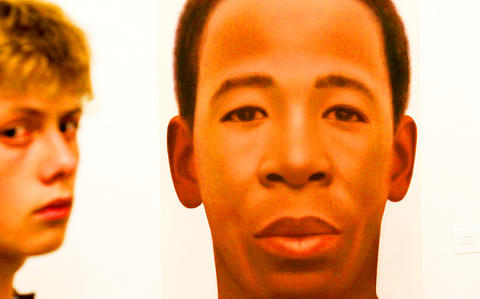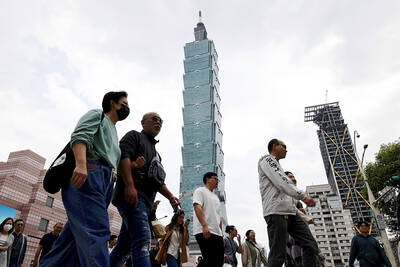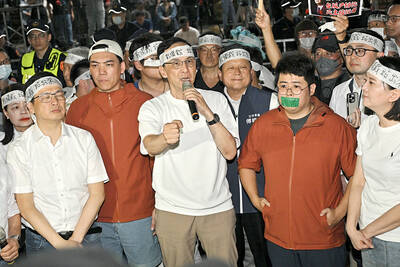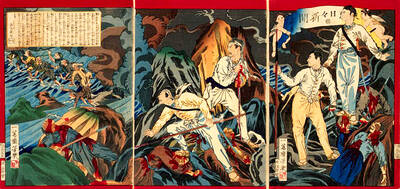The first fair in Africa to focus on selling contemporary African art offers plenty of work reflecting the continent's war, disease and poverty: sculptures of guns with spikes; dark, bloody etchings; installations on the dangers of unprotected sex.
Masks, fetishes and the odd protest poster from South Africa's resistance art movement also are on display. But so is art with more universal themes, such as a wistful sculpture of mother and child.
And still other work is irreverent, pop-oriented and cheeky.

PHOTO: AP
The kaleidoscope of images and themes is fitting backdrop for the debate the Joburg Art Fair has sparked about what it means to be African and an artist. The fair also has got the art world buzzing about tensions between art and commerce.
"Whatever we call African art, I think the African artist exists," said Simon Njami, a Cameroon-born, Paris-based curator who spoke at Thursday's reception, the night before the fair opened to the public. "To be an African ... means to see the world from a specific point of view, which doesn't mean we don't look at our world or only look at our neighborhood."
The Joburg Art Fair, in the city's wealthy financial and shopping district of Sandton, brings together 22 major galleries from Europe, the US and Africa showcasing works on sale from US$150 to US$750,000.
There is work by some of South Africa's top artists such as William Kentridge, photographer David Goldblatt and Gerard Sekoto, regarded as one of the fathers of African modernist painting.
The rest of the continent is well represented with El Anatsui and Owusu-Ankomah from Ghana and Beninese artist Romuald Hazoume.
From Cameroon and based in Paris and Brussels, photographer Bili Bidjocka prefers to be seen as an "international" artist.
"I am an African, without any doubt, but I am also a contemporary artist and I have no difficulties with this," he said.
The fair is something of a homecoming for Cape Town artist Robin Rhode. Since leaving for Berlin in 2003, Rhode has had huge success with his hip, athletic performances and photographic work.
Represented by the New York Perry Rubenstein Gallery, Rhode is a special guest artist at the fair.
"I consider myself an artist of the world," he says. "The labels will continue to exist. But let the art question the validity of that. Then art is not about geography, then the art becomes of the world." Claude Simard, from New York's Jack Shainman Gallery, said African artists "are rooted to Africa through issues such as race, politics, poverty and social issues." He points to South Africa's Zwelethu Mthethwa striking portraits of African migrant workers.
There's no doubt African art - however you define it - is hot. An African Pavilion was set up at the Venice Biennial for the first time last year - grabbing headlines, not least for reports of collections being funded by blood diamonds.
"In America there is also a renewed interest in African art," says Durban-based curator Carol Brown, who consulted on the fair.
She says "the Big Five" draw the most interest - Kentridge, El Anatsui, British stars Chris Ofili and Yinka Shonibare of Nigerian families, and Kenyan potter Magdalene Odundo.
South African-born Marlene Dumas is the most expensive living female artist after a painting sold in London for US$3.34 million.
Based in Amsterdam, Dumas is holding her first solo show in her native country at another Johannesburg gallery.
Two years ago, London auction house Bonhams hosted its first sale focusing on South African art. Old masters, like Jacob Hendrik Pierneef are back in vogue now after being cast aside for their associations with the apartheid past. Prices fetched for works by expressionist Irma Stern and Maggie Laubscher have also hit record levels locally and internationally.
South Africa, buoyed by nearly a decade of economic growth, has seen an increase in the number of wealthy individuals looking to spend money on art and new galleries have opened across the country.
But the South African art-buying public remains small - and is still almost exclusively white.
With post-apartheid South Africa grappling with high unemployment and mass poverty, the handful of public galleries barely have budgets to buy emerging artist's works let alone South African artists fetching record prices on the international market.
Africans rarely even get a chance to see, let alone buy, contemporary art of the continent. Major international exhibitions of contemporary African art rarely come to Africa. Njami's acclaimed Africa Remix, which showed in Johannesburg last year after a world tour, is an exception.
Njami wants there to be more contemporary museums in Africa, more African critics and more involvement in setting the price for the continent's artworks.
"I think it is important for Africa to create its own value and an art fair is very instrumental in that," he says.
He is mindful, though that the fair is also a test of the market and that "what the galleries are showing is what they expect to sell." Critic Anthea Buys wrote in South Africa's Mail & Guardian weekly of what she saw as the "remorselessly" commercial nature of the fair. That sense has left many artists and critics, already suspicious about exploitative dealers, feeling uncomfortable.
"Skeptic" read one of the badges being handed out at the opening night by a top Johannesburg gallery - along with "collector" and "artist." "There is a lot of unease about the interaction between art and money," said Sean O'Toole, editor of Art South Africa. In a recent article he described art dealers as drunk on champagne and "self-congratulatory." Ending his speech on Thursday, Njami urged the well-heeled crowd of art aficionados to buy the works - before they got too expensive, he joked.
"I think it is our responsibility to the future to make sure African creations remain in Africa - or at least some evidence of it," he said, more seriously.
It's not yet clear whether Njami's call will be heeded out of altruism or in the pursuit of good investment returns. But by the end of the evening there were quite a few red sold stickers on the walls.

In the March 9 edition of the Taipei Times a piece by Ninon Godefroy ran with the headine “The quiet, gentle rhythm of Taiwan.” It started with the line “Taiwan is a small, humble place. There is no Eiffel Tower, no pyramids — no singular attraction that draws the world’s attention.” I laughed out loud at that. This was out of no disrespect for the author or the piece, which made some interesting analogies and good points about how both Din Tai Fung’s and Taiwan Semiconductor Manufacturing Co’s (TSMC, 台積電) meticulous attention to detail and quality are not quite up to

April 21 to April 27 Hsieh Er’s (謝娥) political fortunes were rising fast after she got out of jail and joined the Chinese Nationalist Party (KMT) in December 1945. Not only did she hold key positions in various committees, she was elected the only woman on the Taipei City Council and headed to Nanjing in 1946 as the sole Taiwanese female representative to the National Constituent Assembly. With the support of first lady Soong May-ling (宋美齡), she started the Taipei Women’s Association and Taiwan Provincial Women’s Association, where she

Chinese Nationalist Party (KMT) Chairman Eric Chu (朱立倫) hatched a bold plan to charge forward and seize the initiative when he held a protest in front of the Taipei City Prosecutors’ Office. Though risky, because illegal, its success would help tackle at least six problems facing both himself and the KMT. What he did not see coming was Taipei Mayor Chiang Wan-an (將萬安) tripping him up out of the gate. In spite of Chu being the most consequential and successful KMT chairman since the early 2010s — arguably saving the party from financial ruin and restoring its electoral viability —

It is one of the more remarkable facts of Taiwan history that it was never occupied or claimed by any of the numerous kingdoms of southern China — Han or otherwise — that lay just across the water from it. None of their brilliant ministers ever discovered that Taiwan was a “core interest” of the state whose annexation was “inevitable.” As Paul Kua notes in an excellent monograph laying out how the Portuguese gave Taiwan the name “Formosa,” the first Europeans to express an interest in occupying Taiwan were the Spanish. Tonio Andrade in his seminal work, How Taiwan Became Chinese,